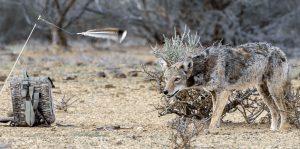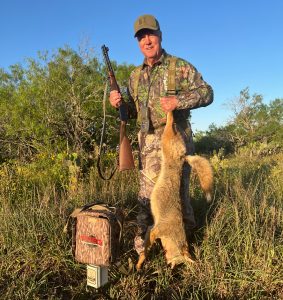 I had been sitting partially hidden, back against a gnarly mesquite, my open-sight R95 .30-30 Win rested in the crux of my crossed shooting sticks for a good five or more minutes with great anticipation. Thirty steps in front of me my Burnham Brothers Freq electronic call broadcast its unique ultra-sonic sounds of a direly distressed cottontail rabbit.
I had been sitting partially hidden, back against a gnarly mesquite, my open-sight R95 .30-30 Win rested in the crux of my crossed shooting sticks for a good five or more minutes with great anticipation. Thirty steps in front of me my Burnham Brothers Freq electronic call broadcast its unique ultra-sonic sounds of a direly distressed cottontail rabbit.
Sweat formed on my forehead, threatening to flow into my eyes. It was hot! My mind drifted to a time many years ago when using a Burnham Brothers mouth-blown predator call I called in my first coyote. I got so excited when the “wolf” charged toward me, I missed that coyote seven times with my dad’s lever-action Model 94 .30-30. Recalling that time, I nearly laughed out loud. Even though I had missed seven rushed and utterly excited shots, I knew one thing for certain. I was not about to quit calling predators, ever!
Part of my reason for calling predators during late spring, even though I had called the same property back in January, was to remove coyotes, bobcats and raccoons. Well, that and the fact I dearly loved calling critters. During the winter I had used my Burnham Brothers C-3 Long Range mouth-blown call, which I carry with me whenever I am in the field. And yes, even raccoons can and do occasionally kill fawns.
Predators have their place, but sometimes their numbers need to be reduced or regulated. One of the things we hoped to do on the property was to increase fawn survival. Growing young families, who hunted the property requested more venison which added deer harvests would provide.
Fawns in the area normally “started dropping” during late May, early June. I hoped to remove as many predators as possible just before fawns were born.
Thankfully the property, or at least part of it, had received excellent rainfall which created considerable ground cover. Ground vegetation not only provided food for wildlife, but also created cover for newborn fawns. Predators would have a hard time seeing and finding them.
Usually, the first week of a fawn’s life, they instinctively do not move from where the doe leave them, essentially hidden. They remain death-like still no matter what approaches or walks by. Predation during these early days is usually minimal. Most fawns are killed by predators when they get a bit older, a time when they spook and run from danger. This is when coyotes and bobcats take their toll.
 Wild hogs? The property I was on had an on-going feral hog removal program which included trapping for several years. This along with continual hunting pressure has reduced wild hog predation of fawns.
Wild hogs? The property I was on had an on-going feral hog removal program which included trapping for several years. This along with continual hunting pressure has reduced wild hog predation of fawns.
A few days prior to my calling session I visited with Gary Roberson with Burnham Brothers Game Calls. Gary in my opinion knows more about hunting coyotes and bobcats than anyone. Gary was responsible for creating the revolutionary Freq electronic predator game call (www.freqcalls.com), which was created through extensive research and a “system” that records distressed prey sounds at their real ultra-sonic frequency, measured in Hertz, but also broadcasts the extra high-pitched frequencies and the low “growling” sounds made by distressed prey species.
Coyotes hear upwards of 45,000 Hertz, bobcats upwards of 65,000 Hertz. All electronic game calls broadcast sounds only up to 17,000 to 18,000 Hertz, no matter how high the volume is turned up other than the Freq call.
The Freq produces and broadcasts distressed prey calls at 55,000 Hertz. That’s what sets the Freq call so far apart from and above any other electronic game call. It broadcasts at Hertz levels that critters actually hear. Beyond attracting uncalled predators, Burnham Brothers’ Freq brings in call-shy predators, coyotes and bobcats that have quit coming to “regular” electronic calls.
Prior to heading to the property I called my old friend Gary Roberson to ask him not only about some of his latest predator hunting adventures (this to record one of my weekly “DSC’s Campfires with Larry Weishuhn” podcasts with him, available on Spotify, Applepodcasts, iHeartPodcasts, outdooraction.com, waypointtv.com, carbontv.com and many others), but also to ask what I might expect calling in warm weather and what advice he might have in my doing so.
“I don’t really do things a whole lot differently than what I do when calling in cold weather. But always remember it does no good to call in critters and not be able to see them. Always set up where you can see coyotes or bobcats respond, and, be patient. During warm or hot weather, it seems like coyotes are slower in responding, and bobcats generally nearly always a lot slower than during cool to cold weather. Be patient when calling.” Answered Gary.
I was taking Gary’s statement to heart by waiting. Like him, I exclusively only call predators during daylight hours. Also, like Gary, I like to see predators approach, actually watch how they respond. I guess I could use some of the night-time tools, such as the various thermal devices we have available these days to do some of that after dark. Maybe someday I will those new tools. But for now, I only call predators during daylight hours. Guess, I’m old school in that and likely numerous other respects.
One of the other things Gary and I talked about prior to my hunt was our current choice of firearms and ammo. “As I’ve gotten older, I find myself drawn back to where I started, hunting with open-sight lever-action rifles. The “new” in my current tack is our Freq call and Hornady’s LEVERevolution ammo. These days I shoot a Ruger/Marlin Model 336 .30-30 Win, open sights. Love it! Calling coyotes or bobcats to me is a close-range game. A lever-action is quick pointing, accurate and if a follow-up or second shot is available or required, I sometimes even amaze myself how quickly I can accurately shoot a second shot.”
To which I responded, “I appreciate my bolt-action Mossberg rifles. I truly enjoy hunting with them and shooting steel targets at long range. I particularly like my 7mm PRCs topped with Stealth Vision scopes shooting Hornady Precision Hunter ammo. Although I can accurately shoot those rifles at steel out to 1,200-yards, when it comes to hunting, I want to get as close to the animal as possible. But I also find myself grabbing one of my Rossi lever-actions R92s chambered in.45 Colt or .44 Mag, or my R95 in .30-30 Win when calling predators, hunting hogs and even deer. Doing so takes me back to my early days of hunting!”
“Yes Sir, and there’s something “comforting” about hunting with a lever-action. I’ve just about decided to do most all my hunting with a lever-action rifle and/or a single-action revolver.” Stated Gary.
Meanwhile back on the hunt it had not gotten any cooler. Thankfully there was a slight breeze but not blowing hard to the point of messing up the calling. I sat patiently and waited, remembering Gary instructions to remain patient, real patient.
After twenty minutes without any obvious response, I was just about to get up to walk back to my vehicle then drive to another location. That’ is when I spotted slight movement coming my way, a deliberate and slow-moving bobcat. Patience indeed was about to pay dividends.
